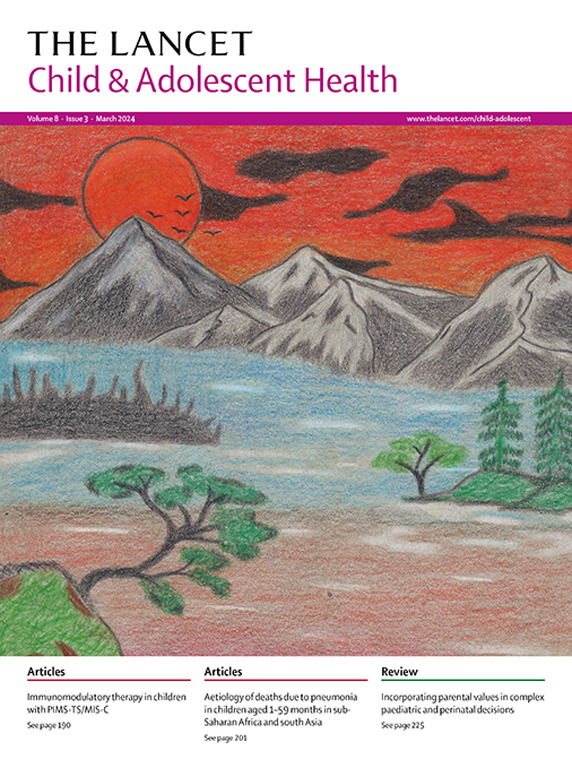National, regional and provincial prevalence of childhood hypertension in China in 2020: a systematic review and modelling study
IF 19.9
1区 医学
Q1 PEDIATRICS
引用次数: 0
Abstract
Background
Childhood hypertension is a growing health concern in China. Accurate estimation of prevalence is essential but challenging due to the variability of blood pressure and the need for multiple occasions for confirmation. This study aimed to estimate the national, regional, and provincial prevalence of childhood hypertension in China in 2020.
Methods
For this systematic review and modelling study, we did a comprehensive literature search of epidemiological studies reporting the prevalence of elevated blood pressure (EBP) or hypertension among Chinese children (aged 18 years or younger) that were published between Jan 1, 1990 and June 20, 2024 in PubMed, Embase, MEDLINE, China National Knowledge Infrastructure, Wanfang Data, and Chinese Science and Technology Journal Database. EBP was defined as blood pressure greater than or equal to the 95th percentile on a single occasion, and childhood hypertension as blood pressure greater than or equal to the 95th percentile consistently across three occasions. First, we estimated the prevalence of childhood EBP using a multi-level mixed-effects meta-regression and the pooled odds ratios (ORs) for factors associated with childhood EBP through random-effects meta-analysis. Second, the ratio of childhood EBP to childhood hypertension was calculated via random-effects meta-analysis, based on which the national and regional prevalence of childhood hypertension was imputed. Finally, we derived the provincial prevalence of childhood hypertension using an associated factor-based model. The review protocol was registered in PROSPERO (CRD42024537570).
Findings
We identified 8872 records, of which 134 articles covering 22 431 861 children were included. In 2020, the overall prevalence of hypertension among Chinese children aged 6–18 years was 3·11% (95% CI 2·35–4·04), equivalent to 6·80 million (5·13–8·83) affected children. The prevalence of childhood hypertension ranged from 2·25% (1·54–2·75) for children aged 6 years to 2·01% (1·36–3·37) for those aged 18 years, peaking at 3·84% (2·97–4·94) for those aged 14 years. The overall prevalence was higher in boys (3·34% [2·53–4·35]) than in girls (2·85% [2·13–3·69]). Associations between four factors (overweight, obesity, salted food intake, and family history of hypertension) and childhood EBP were graded as highly suggestive evidence.
Interpretation
This study reveals substantial regional and provincial variations in the prevalence of childhood hypertension in China. Our findings could inform targeted public health initiatives and optimise resource allocation to address this public health concern.
Funding
This study was supported by the National Natural Science Foundation of China (72104211 and 82273654) and the Chao Kuang Piu High-tech Development Fund (2022RC019).
Translation
For the Chinese translation of the abstract see Supplementary Materials section.
2020年中国全国、地区和省级儿童高血压患病率:系统回顾和模型研究。
背景:儿童高血压是中国日益严重的健康问题。准确估计患病率至关重要,但由于血压的可变性和需要多次确认,因此具有挑战性。本研究旨在估算 2020 年中国全国、地区和省级儿童高血压患病率:在这项系统综述和模型研究中,我们对 1990 年 1 月 1 日至 2024 年 6 月 20 日期间发表在 PubMed、Embase、MEDLINE、中国国家知识基础设施、万方数据和中国科技期刊数据库中的有关中国儿童(18 岁及以下)血压升高(EBP)或高血压患病率的流行病学研究进行了全面的文献检索。EBP定义为单次血压大于或等于95百分位数,儿童高血压定义为三次血压均大于或等于95百分位数。首先,我们使用多水平混合效应荟萃回归估算了儿童 EBP 的患病率,并通过随机效应荟萃分析估算了与儿童 EBP 相关因素的集合赔率比(ORs)。其次,通过随机效应荟萃分析计算出儿童 EBP 与儿童高血压的比率,并在此基础上推算出全国和地区的儿童高血压患病率。最后,我们利用基于相关因素的模型得出了各省的儿童高血压患病率。研究方案已在 PROSPERO(CRD42024537570)上注册:我们发现了 8872 条记录,其中 134 篇文章涵盖 22 431 861 名儿童。2020年,中国6-18岁儿童高血压总患病率为3-11%(95% CI 2-35-4-04),相当于6-8千万(5-13-8-83)名患病儿童。儿童高血压患病率从6岁儿童的2-25%(1-54-2-75)到18岁儿童的2-01%(1-36-3-37)不等,14岁儿童的患病率最高,为3-84%(2-97-4-94)。男孩的总体患病率(3-34% [2-53-4-35])高于女孩(2-85% [2-13-3-69])。四项因素(超重、肥胖、腌制食物摄入量和高血压家族史)与儿童 EBP 之间的关系被评为高度提示性证据:本研究揭示了中国儿童高血压患病率在地区和省份间的巨大差异。我们的研究结果可为有针对性的公共卫生措施提供信息,并优化资源分配,以解决这一公共卫生问题:本研究得到了国家自然科学基金(72104211和82273654)和潮光飘高科技发展基金(2022RC019)的资助:摘要中译文见补充材料部分。
本文章由计算机程序翻译,如有差异,请以英文原文为准。
求助全文
约1分钟内获得全文
求助全文
来源期刊

Lancet Child & Adolescent Health
Psychology-Developmental and Educational Psychology
CiteScore
40.90
自引率
0.80%
发文量
381
期刊介绍:
The Lancet Child & Adolescent Health, an independent journal with a global perspective and strong clinical focus, presents influential original research, authoritative reviews, and insightful opinion pieces to promote the health of children from fetal development through young adulthood.
This journal invite submissions that will directly impact clinical practice or child health across the disciplines of general paediatrics, adolescent medicine, or child development, and across all paediatric subspecialties including (but not limited to) allergy and immunology, cardiology, critical care, endocrinology, fetal and neonatal medicine, gastroenterology, haematology, hepatology and nutrition, infectious diseases, neurology, oncology, psychiatry, respiratory medicine, and surgery.
Content includes articles, reviews, viewpoints, clinical pictures, comments, and correspondence, along with series and commissions aimed at driving positive change in clinical practice and health policy in child and adolescent health.
 求助内容:
求助内容: 应助结果提醒方式:
应助结果提醒方式:


